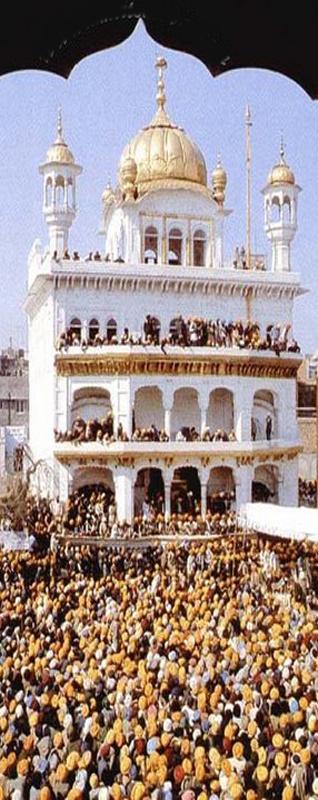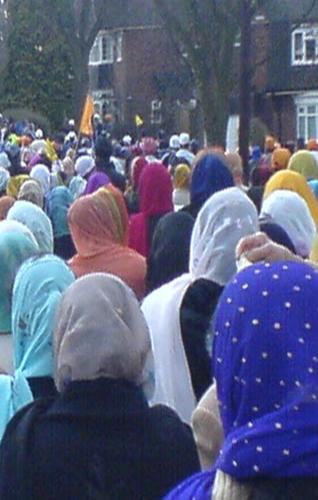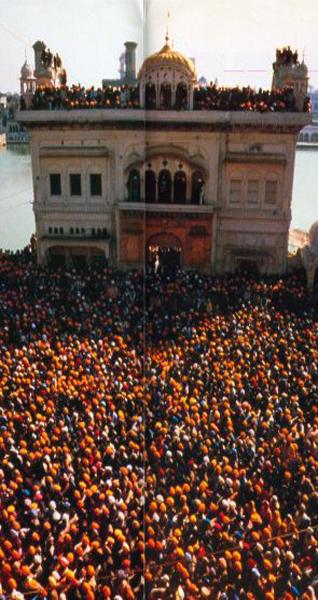Columnists
The Sarbat Khalsa:
Landsgemeinde of The Sikhs? Part II
by Dr JOGISHWAR SINGH
Continued from yesterday ... Part II
Guru Gobind Singh infused a new spirit into his Sikhs, with each believing himself as much a leader as any other. The Sikhs earned their Guru’s trust in them.
“After bringing into being a revolutionary organisation, the Guru placed a revolutionary ideal before his men, the objective of the Raj Khalsa or people’s democracy”, writes historian Arjan Dass Malik..
Fired with a missionary zeal, the Sikhs not only withstood a genocide after the Guru’s death but also showed in practice how the power of faith produced leadership qualities without blind obedience to any one individual. This trait can be illustrated by innumerable examples from those times down to the present day.
It has been rightly pointed out by historian Khushwant Singh that “mindless obedience and self effacement .... is not possible among guerrilla units because a guerrilla force is essentially a political army organised on democratic ines”.
This trait, developed during the Sikh guerrilla war of 1710-1768, did not disappear from the Sikh bent of mind and obedience attitudes.
During the period leading up to the acquisition of political sovereignty by the Sikhs in Punjab, decision making was carried on through the Sarbat Khalsa and the Gurmatta.
The Sarbat Khalsa was the general assembly of the Sikhs, taking place twice a year at Amritsar.
A resolution passed by such an assembly was the Gurmatta (Guru’s decree).
The Sarbat Khalsa appointed jathedars (group leaders), whose agents and entrusted them with powers to negotiate on behalf of the Panth. There was no obedience to one single powerful individual.
The political system of the Sikhs has been described as a “federative republic” by noted Muslim historian, S.M. Latif. When deemed necessary, an individual was delegated specific powers by common consent through a majority decision. He was barely allowed the dignity of primus inter pares - "first among equals".
“Among the Khalsa no pre-eminence was allowed except that which merit and ability naturally give ... anyone who possessed the strength of arms, determination and organising ability could ride with followers behind him and call himself a Sirdar”.
Not only this, “the democratic functioning of the army gave the individual soldiers a feeling that he was his own leader and the duties he was carrying out were self imposed”. He was “subordinate to none and was his own leader”.
This attitude was confined not just to the political or religious sphere but was also extended to other spheres of the Sikh way of life. Khushwant Singh described Banda Singh Bahadar’s efforts as a “peasant upsurge in eastern Punjab”. He was able to rouse a “downtrodden peasantry to take up arms. In seven stormy years, Banda changed the class structure of land holdings in the southern half of the state by liquidating many of the big Muslim zamindar families of Malwa and the Jullundur Doab. Large estates were first broken up into smaller holdings in the hands of Sikh or Hindu peasants. With the rise of Sikh power, these holdings were once again grouped together to form large estates, but in the hands of Sikh chieftains.”
This process did not, however, take land away from many small peasant proprietors given land by Banda Singh. “Banda confiscated hereditary land grants (“jagirs”) and distributed them among landless farmers”.
The tradition of a preponderance of small peasant proprietors in the Punjab can be traced back to Banda. As peasant proprietors, the Sikhs extended their independence in decision making assemblies of the Sarbat Khalsa. They were directly affected by whether political authority followed policies safeguarding their economic well being or functioned only through extortionist tax collectors. Agriculture became the favoured occupation of these peasant proprietors.
From this time onwards can be traced how political decisions affecting agricultural operations become important factors in determining Sikh attitudes towards political authorities.
Chronologically, the formation of Sikh confederacies known as Misls dates from before 1768. This formation occurred in the 1740s when foundations of this system were laid. The year 1768 has been chosen as a determinant point because the Misls become unchallenged masters in the Punjab after Ahmad Shah Abdali’s ninth and last invasion in 1769. Misl chieftains gradually deviated from the pristine idealism that had characterised the founders of this system like Sardar Jassa Singh Ahluwalia and Nawab Sardar Kapur Singh Fyzullpuria.
There were twelve Misls. However, in this system, obedience was not granted automatically. Troopers joined chieftains of their own free will. They left when they wanted to. They were quite “at liberty to abandon the profession of arms or to transfer their military allegiance from one chief to another”. The Misl chieftains could not take their followers’ obedience for granted. They had to continuously respect the wishes of their adherents.
“It was only by such means that they could hope to retain them in their service, the slightest show of indifference exhibited by a chief to the interests of his fighting men, invariably ending in the latter going over to another chief”.
This is similar to decisions by the Landsgemeinde, determining whether its adherents fighting in various military formations owed allegiance to this or that leader.
Transfer of allegiance was not treated as desertion or treachery. It was every Sikh’s inherent right, just as it had been every Swiss’s inherent right over the preceding centuries. The Sikh and the Swiss had the freedom to choose the recipient of their allegiance. There was no question of accepting regimented discipline as understood in modern military sense.
This did not mean that the Swiss or the Sikhs were not good fighters. It meant that they were just not willing to accept discipline like sheep.
They considered themselves as good as any other person claiming allegiance from them. Obedience was given voluntarily, not coerced.
An English traveller, George Forster, describes the Sikh polity, thus, in 1783: “Sikh government seemed to be an aristocracy but on closer examination revealed a large vein of popular power branching through many of its parts ... No honorary or titular distinctions were conferred on any member; punishments were rarely inflicted in the army; equality of rank was maintained in civil society which no class of men however wealthy or powerful were suffered to break down”.
Meeting a Sikh on one of his travels in the hill areas of Uttar Pradesh, the Englishman asked him who his chief was. “He told me (in a tone of voice and with an expression of countenance which seemed to revolt at the idea of servitude) that he disdained an earthly superior and acknowledged no other master than his prophet Govind Singh”.
These words ring in my mind when I see images of tall, proud Swiss warriors from central Switzerland with their long beards, luxurious moustaches and long pikes, their feared weapon of choice which inflicted numerous defeats on knights mounted on their armoured chargers.
There was no question of accepting any chief as unquestioned sovereign. The practice of Gurmatta and the Sarbat Khalsa were followed as before. There was a confederal polity and no personal despotism or obedience to the sovereignty of a single individual.
“A nation was up in arms against its enemies and it is the collective efforts of the masses rather than individual achievements that ultimately made the revolution a success”, writes historian N.K. Sinha.
A Punjabi saying reflects this tradition of those times: “Khalsa so jo nit karey jung” (Khalsa is he who daily goes to war). The “jung” in question was an unceasing struggle against tyranny and intolerance practised by ruling authorities.
Similar patterns are observable in Swiss history with its long series of defeats inflicted on oppressive foreign rulers seeking to blight long standing Swiss traditions of autonomous decision-making by peasant proprietors doubling up as soldiers in defence of their homeland or their rights.
Removal of foreign danger saw the outbreak of intense rivalry between various Sikh chieftains, till then held in check by the supreme need of uniting in the face of persecution. These rivalries constitute a characteristic that has been continuously affecting Sikh politics till the present day. As soon as the need to combat oppressive political authority recedes into the background, internecine rivalries come to the fore because of a spirit of refusal to recognise obedience to others, unless gained voluntarily through respect of the religious ethos of the obedience giver.
George Forster had already foreseen in 1783 that some ambitious chief would display the standard of monarchy.
The Swiss, unlike the Sikhs, never allowed any form of monarchy to evolve out of their traditional system of autonomous decision-making. As a Swiss citizen, I am proud of this fact which I find as a striking characteristic of the Swiss polity.
The Sikh experiment in monarchy did not last long because, among other reasons, there was no respect in the Sikh psyche for the monarchical ideal and no tradition of obedience to it.
Dr. N.K. Sinha’s comment is apt: “What might have been the most novel experiment in statecraft, degenerated later, in the nineteenth century, into a military monarchy ... which, though it dazzles by early success, spells ultimate failure”.
The Swiss did not succumb to such failure. Even while gradually abandoning the main features of the Landsgemeinde system, they never allowed a monarchy or ennobled aristocracy to usurp political authority.
Ranjit Singh’s monarchy did not conform to the kind of democratic polity envisaged in the ideals of Guru Gobind Singh’s vision of the Khalsa. Unquestioning obedience to a hereditary monarchy had no place in Sikh mores enunciated by their Tenth Guru.
Conscious of these ideals, I as a Sikh-Swiss find the Swiss political system as a very appropriate result of a long political tradition based on freedom loving traits of independent peasant proprietors of land who had achieved their freedom by the force of their own valour against oppressors possessing stronger military strength. The Swiss kept alive the spirit of their Landsgemeinde, rejected all attempts at foisting monarchical regimes on them and evolved a unique model of a Confederation that allows harmonious moulding of three separate cultures into a unique Swiss identity.
The German speaking Swiss do not want to be thought of as Germans. The French speaking Swiss do not want to be mistaken as French. The Italian speaking Swiss do not want to be taken for Italians. They are proud of their Swiss identity.
History allows no room for ifs and buts. However, I cannot sometimes avoid fantasising whether the Sarbat Khalsa system could have been capable of allowing the Sikhs to evolve their political system into something resembling the modern day Swiss system of direct democracy, had it not been distorted and gradually eclipsed by a system of hereditary monarchs negating all the fundamental democratic trends infused by Guru Gobind Singh amongst his followers.
A majority of Sikhs live today in India which does not have its former Rajas and Maharajas. However, the fundamental importance of the Sarbat Khalsa as the fulcrum of community decision making has never been restored amongst Sikhs.
The Swiss managed to retain the essential ethos generated by their Landsgemeinde.
The Sikhs have not managed to have similar success with their Sarbat Khalsa.
CONCLUDED
[Dr. Jogishwar Singh was with the IAS (Indian Administrative Service) before leaving India in 1984, the year of cataclysmic events for Sikhs in India. With an M.Sc. (Hons School) in Physics and an M.A. in History from Panjab University, Chandigarh, he did his D.E.S.S. at Sorbonne in Paris, followed by a Ph.D. from Ruprecht-Karls University in Heidelberg, Germany. Now a Swiss citizen based in Le-Mont-sur-Laussanne, he is serving as a Managing Director with the world famous Rothschild Group in Geneva, having earlier served as Senior Vice-President, ING Bank, Switzerland and Director with the Deutsche Bank Switzerland. He is fluent in eight languages and has basic knowledge of two others.]
December 20, 2011
Conversation about this article
1: Sangat Singh (Kuala Lumpur, Malaysia), December 20, 2011, 1:54 PM.
So long as there are political appointees at the Akal Takht, the Sarbat Khalsa will remain elusive.
2: Baldev Singh (Bradford, United Kingdom), December 20, 2011, 8:36 PM.
Reading this great article, I wonder how many Sikhs knew anything about all of this and how it functioned? And about Ranjit Singh's emoire? It was a completely secular set up; it had no capital punishment, no sectarian discrimination; yet his power was absolute and unchallenged. Perhaps sikhchic.com can feature more articles from those chapters of our rich history.
3: Sukhmeet Singh (Hyderabad, India), December 20, 2011, 11:08 PM.
Very insightful article: the author's knowledge about both the Swiss and the Sikhs is awesome. Also impressed by the author's education and knowledge of so many languages!
4: Gurjender Singh (Maryland, U.S.A.), December 21, 2011, 9:46 AM.
Thank you very much for providing such detailed information related to the Sarbat Khalsa. I think there is complete difference between the new and old traditions of the Sarbat Khalsa. In old days (may be 100-200 years ago), the common people were interested in joining this due to their non-political involvement and interests which are common to all in the human race who believe in one God. But now it has become a political stage and limited to only local and known Sikhs. This has lost it mass-appeal because it does not serve them. Maybe the leadership should learn a lesson from this article and draw the populace back in.
5: Harpreet Singh (Delhi, India), December 22, 2011, 1:36 PM.
Enjoyed reading the article and am glad to know more about S. Jogishwar Singh Ji, especially his love for Sikhi. A few months ago, I read his lengthy article about Maharaja Ranjit Singh in the 'Abstract of Sikh Studies'. Liked it very much. Please publish his articles regularly.






